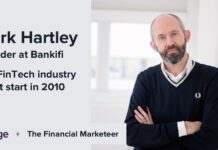Listen to the podcast
Interview with Simon Mott, CMO at TrackInsight
Simon Mott is a marketer with two-decades worth of experience working in financial services. Living a career that has taken him from working with start-ups, to working in organisations such as FTSE Russell.
Simon has most recently joined TrackInsight, a company that provides data on ETFs (exchange traded funds) as the firm’s new CMO, a role which will see him establishing the business’s marketing function.
“ETFs have really been a very revolutionary investment product, they’ve got a lot of traction, especially in recent years. It’s a high growth market…that’s really democratised investing.
“An individual investor can trade the same product with the same information and the same features as the biggest institution in the world…it’s really created a huge level playing field for investors of all types”
Historically, TrackInsight has provided services to the professional investment community by providing data on all of the ETFs on stock exchanges around the world.
“TrackInsight has been one of the few companies that has really addressed the need for a comprehensive and independent global set of data around [the ETF] market.”
Aside from providing data, TrackInsight has also served its audience in other ways.
“…we hold a series of very small, highly produced conferences…in investment centres around the world…they are forums where big institutions and serious buyers can get together and discuss the state of the industry.”
TrackInsight, as Simon explains, is in a high-growth phase stretching from its European roots to having global ambitions.
Starting from the beginning
“It’s actually the second time in my career that I’ve walked into an organisation that’s had very little marketing discipline or infrastructure. I joined two months ago and prior to that, there had never been a formal marketing role at the organisation.”
Marketing, it seems, has until now been a role shared by various people within the organisation including the sales team.
“Given where we are in the growth process, I think there was a need for a little bit more rigour, process and discipline…around a more centralised marketing function.
“I’m not exactly joining with a blank canvas, but certainly at an early stage in the marketing journey for the company.”
Approaching marketing from the start
“The way I’m approaching it is to look and see what these expansion plans are and what that means in terms of requirements from technology, brand, people and skills.”
Skills are a big part of Simon’s focus to get TrackInsight’s growth plans in motion, with the firm focussed on recruiting the right team to enable the growth the firm wants to achieve.
“[Getting ready for growth] comes down to technology and processes and it means we need to have people who are familiar with those systems and understand what it means to have an agile, scalable, digitally-driven marketing organisation.”
The COVID-19 pandemic and uncertainty
Simon, as is to be expected, made reference to the level of uncertainty organisations are having to deal with as a result of the COVID-19 pandemic.
“…it’s difficult to think in a two-to-three year horizon at the moment, but what I think we can say is that we can put our best foot forward with a strong technology backbone…which is going to serve us well over the longer term.”
Picking the correct technology
I asked Simon about a subject that comes up a lot in marketing today; how can marketers pick from the huge number of technology options available to them?
“…finding the right combination [of technology options] is difficult. I think part of it comes from experience and part of it comes from talking with peers and understanding how they’ve approached things.
“What a lot of people have in financial services…is a tremendous mish-mash of old technologies…and what they don’t do is integrate very well.”
As a result, Simon takes an approach that he calls ‘360-degree marketing’. “What I’m trying to do is understand what my audience-base is doing with TrackInsight across different properties and across different types of media.”
This means Simon has his sights set on understanding how his audience engages with TrackInsight across various platforms, from the firm’s website through to its advertising, presence on social media and at events.
Simon explains that he wants to build a technology system that captures this information “so we can build up a much fuller picture of those people, their interests and their behaviours.”
Risk and innovation
It’s at this point that Simon also discusses how risk-averse some financial brands are when it comes to their marketing.
“I think we don’t experiment enough within financial services…people are very conscious of their brand, they don’t want to do things that are going to make them look silly and they don’t want to do things that are going to damage the credibility and trust that they’ve spent, in some cases, decades establishing.
“The risk of that attitude is that you don’t innovate, test and try new things.”
Simon also discusses how new generations of customers have different needs to previous generations.
“I think there needs to be the conversation [with your audience]; what do you want? How do you want to interact with us?
“Some of that can be done in one-to-one conversations or within small groups, but I think there’s a lot of value to be taken from the metrics you can now get from digital platforms.”
Behaviour is worth a thousand words
“…actually tracking what people do, where they spend their time, what types of content they interact with tells you a lot about what you’re doing right and what you’re doing wrong.”
Simon explains that taking this approach can ensure that the correct messaging reaches the correct audience and conversely, audiences aren’t having to put up with irrelevant content.
“A simple combination of a CRM, a marketing automation system, social monitoring, email and website monitoring gives you a massive data set and it’s a data set that isn’t often enough used to its full potential.
“One thing which I’m focussed on in terms of hiring is people with good analytical skills who can get into this data and really bring out useful insights.”
Being paid to fail
“My view of marketing is that you’re being paid to fail.
“…the period of reflection [at the end of a campaign] shouldn’t be about blaming people…that’s the wrong way of thinking about things…you’re going to get things wrong more often, with more people than you’re going to get it right.”
It’s an interesting perspective to view things from, but as Simon explains, marketers are in place to test and learn and that process, by definition, means that some of that learning will come from ‘mistakes’.
“The data helps you do that and helps you find out where people are dropping off or which part of the process is potentially not working so well…so you go back and you try again.”
Managing a brand
Our conversation moves into the all encompassing area of brand.
“[Brand] is definitely not just about a new website and a new logo. Transformational brand change is really a cultural thing within an organisation.
“Within a smaller organisation I think it’s really about how do you want people to react to you…do I want them to feel safe? Do I want them to feel happy?”
Bravery in brand marketing
“I don’t think there is enough bravery in our industry when it comes to doing things differently.
“What I think is endemic within a lot of financial services and definitely with asset management is this horrific group-think and a real sense that ‘I don’t want to depart too far from the crowd’.
“I think that those who are brave get copied very quickly because once the precedent is set people feel much more comfortable following than they do leading. I think it’s one of the reasons financial services has been held back for so long.
“My guy instinct and 20 years in the business tells me there’s just not enough people out there who are willing to really stick their neck out and say that ‘we don’t just need to keep up with the Joneses’…there’s not enough differentiation.”
Difficult for the uninitiated
Simon also discusses how inaccessible financial services can be for audiences.
“Something as simple as car insurance or mortgages…is an intimidating and confusing world…this is why you have these comparison websites to choose which electricity supplier you have. Even these basic decisions are difficult for the uninitiated.
“…we can become more accessible and probably win a whole load more of new business if we change the way we speak.”
Going on a marketing journey
As usual, to finish our conversation, I asked Simon what advice he would give to would-be marketers in the financial services industry.
“First of all [I’d say don’t] limit yourself to the idea that ‘I’m just a marketer’…really educate yourself about the business you’re working for and the product it sells.
“…[secondly, but perhaps] less doable in our current intangible and virtual world is to get out there and speak to people, relationships really matter.”
Finally, Simon returns to his points raised on bravery; “…you’re at a point in your career when you’re starting when you can take risks…you’re allowed to have ideas. If you’re at a healthy company with a good culture they’ll encourage you to speak up.
“…you’ve got doers and you’ve got reviewers, there are a lot more reviewers in any business than there are doers…it’s much harder to come up with an idea in the first place,
“…without these brave people out there saying, ‘hey, there is a different way we can think about this’…nothing ever moves forward.”











